427. Once again. With Sirrah (*0) close
to the Full Moon in September 20 (263) the Sun would be
at Bharani in May 1 (263 - 183 + 41 = 121) and at Naos
in July 20 (201 = 121 + 80):
|
Bharani (*41.4) |
Naos (*121.3) |
 |
Spica (*202.2) |
 |
 |
 |
|
Ca2-15 (41) |
Ca5-16 (121) |
*Ca14-21 (384) |
|
May 1 (121) |
July 20 (201) |
April 8 (464) |
|
"March 21 (80) |
"June 10 (161) |
JUNE 10 (161) |
At the time of Bharani the position
of heliacal Naos in "June 10 (161 = 201 - 41) would
in a way have
corresponded to the position of Spica in JUNE 10
(161 = 354 / 2 - 11). I have been forced to introduce yet
another style in order to show the
dates in the age
of Virgo - when she was at the Sun 172 days after
the DECEMBER solstice.

Spica (282 = 464 - 182 = October 9) -
Bharani (121) = 161. I.e., when Bharani had been at 0h
then Naos would have been at right ascension day *81
("June 10) and Spica at right ascension day *81
+ 80 = *161 ("August 29, 241). In other words: 282 (October 9) - 41 = 241 ("August
29) = "June 10 (161) + 80.
|
JUNE 7 (*88) |
8 |
9 |
10 (161 = 241 - 80) |
11 |
12 |
 |
 |
 |
 |
 |
 |
|
*Ca14-18 |
*Ca14-19 |
*Ca14-20 (383) |
(378 + 6) |
*Ca14-22 |
*Ca14-23 |
|
CLOSE TO THE SUN: |
|
6 (461 - 182 = 279) |
7 (*200) |
8 |
Oct 9 (282) |
10 |
11 (284) |
|
"Aug 26 |
27 |
28 (*160) |
29 (241 = 282 - 41) |
30 |
31 |
|
AL DAFĪRAH (Tuft) = β Com. Ber.
(199.4) |
σ Virginis (200.4)
*159.0 = *200.4 - *41.4 |
γ Hydrae (201.0), ι Centauri (201.4) |
Al Simāk-12 (Lofty) /
Chitra-14 (Bright One) /
Horn-1 (Crocodile) /
Sa-Sha-Shirū-20
(Virgin's Girdle) /
ANA-ROTO-3 (Middle pillar)
MIZAR =
ζ
Ursae Majoris (202.4), SPICA =
α
Virginis, ALCOR = 80 Ursae Majoris
(202.7)
SADALMELIK (α Aquarii)
*161.0 = *202.4 - 41.4 |
71 VIRGINIS
(203.6) |
no star listed (204) |
|
CLOSE TO THE FULL MOON: |
|
(86 + 375 = 461) |
(462 - 366 = 96) |
April 7 |
8 (464 = 16 * 29) |
9 |
10 (100) |
|
"Terminalia |
"Bissextum |
"Febr 25 |
26 (464 - 42 = 422) |
27 (423 - 365 = 58) |
28 (59 = 2 * 29½) |
...
The leap day was introduced as part
of the Julian reform. The day
following the Terminalia (February
23) was doubled, forming the 'bis
sextum - literally 'double
sixth', since February 24 was 'the
sixth day before the Kalends of
March' using Roman inclusive
counting (March 1 was the 'first
day'). Although exceptions exist,
the first day of the bis sextum
(February 24) was usually regarded
as the intercalated or 'bissextile'
day since the third century.
February 29 came to be regarded as
the leap day when the Roman system
of numbering days was replaced by
sequential numbering in the late
Middle Ages ...
|
|
1h (15.2)
β Phoenicis (15.1), υ Phoenicis, ι
Tucanae (15.6), η Ceti, ζ Phoenicis
(15.7) |
Al Batn Al Hūt-26 (Belly of the Fish) /
Revati-28 (Prosperous) /
1-iku (Field Measure)
MIRACH (Girdle) = β Andromedae, KEUN MAN
MUN (Camp's South Gate) = φ Andromedae
(16.0),
ANUNITUM = τ Piscium
(16.5),
REVATI (Abundant) = ζ Piscium
(16.9)
REGULUS
(α Leonis) |
ν Phoenicis (17.4), κ Tucanae (17.6)
*342 = *383.4 - *41.4 = 421 - 80 + 1 |
no star listed (18) |
ADHIL (Garment's Train) = ξ Andromedae
(19.3), θ Ceti (19.7) |
KSORA (Knee) = δ Cassiopeiae
(20.1), ω Andromedae (20.6), γ Phoenicis
(20.8) |
|
DEC 7 |
8 |
9 |
10 (161 + 183) |
11 |
12 (*266) |
In April 8 (365 + 396 / 4 = 464 = 16
* 29) the Full
Moon would have been at Spica. At the time of
Bharani the Full Moon would have been at Spica in
day 241 ("August 29) + 182 = 423 = 366 + 57
("February 27 → 2 / 27 →π) =
464 - 41.
365 + 57 = 422 ("February 26)
ought to have correspond to 344 (DECEMBER 10) because
161 (JUNE 10) + 183 = 344.
I have here used the hura type
of glyph in order to underline that Ca2-15 (41) and
Ca5-16 (121) probably were identifying 0h, whereas *Ca14-21
(384) could have been related to a place defined from the Full Moon
(Hotu).
 |
 |
Drus (*119.9) =
χ Carinae |
|
hura |
Ca5-14 |
'June 21 (199 - 27) = solstice |
| Hura.
1. To
fish with a small funnel-shaped net tied
to the end of a pole. This fishing is
done from the shore; fishing with the
same net, but swimming, is called
tukutuku. 2. To be active, to
get moving when working: ka hura, ka
aga! come on, get moving! to work!
3. Tagata gutu hura, a
flatterer, a flirt, a
funny person, a witty person.
Hurahura, to dance, to
swing. Vanaga. 1. Sling. In his brilliant study of the distribution of
the sling in the Pacific tracts, Captain
Friederici makes this note (Beiträge zur
Völker- und Sprachenkunde von
Deutsch-Neuguinea, page 115b): 'Such,
though somewhat modified, is the case in
Rapanui, Easter Island. The
testimony of all the reporters who have
had dealings with these people is
unanimous that stones of two to three
pounds weight, frequently sharp chunks
of obsidian, were thrown by the hand; no
one mentions the use of slings. Yet
Roussel includes this weapon in his
vocabulary and calls it hura. In
my opinion this word can be derived only
from the Mangareva verb kohura,
to throw a stone or a lance. So far as
we know Rapanui has received its
population in part by way of Mangareva.'
To this note should be added the
citation of kirikiri ueue
as exhibiting this particular use of
ueue in which the general sense is
the transitive shake. 2. Fife, whistle,
drum, trumpet, to play; hurahura,
whistle. P Mq.: hurahura, dance,
divertissement, to skip. Ta.: hura,
to leap for joy. Pau.: hura-viru,
well disposed. Churchill. H. Hula,
a swelling, a protuberance under the arm
or on the thigh. Churchill 2. |
These 3 stars were female in
character. Bharani was the female organ of
reproduction (Yoni) and the leading star in
Virgo (the Virgin) was Spica. For canoes (ships) the stern
was
reserved for the woman with child:
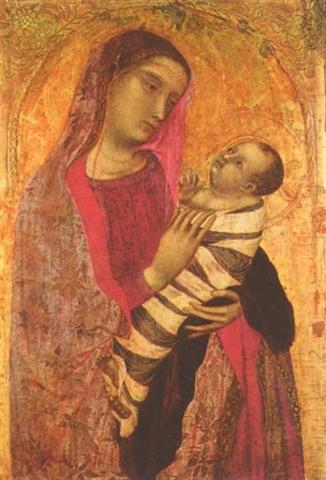
Whereas the
stronger males were placed up front. She was guiding the
direction of the canoe while he was working hard.
And ships were always females. Argo Navis was
practically no more than the stern of a ship.
...
It is
an interesting fact, although one little commented
upon, that myths involving a canoe journey, whether
they originate from the Athapaskan and north-western
Salish, the Iroquois and north-eastern Algonquin, or
the Amazonian tribes, are very explicit about the
respective places allocated to passengers.
In the case of maritime, lake-dwelling or
river-dwelling tribes, the fact can be explained, in
the first instance, by the importance they attach to
anything connected with navigation: 'Literally and
symbolically,' notes Goldman ... referring to the
Cubeo of the Uaupés basin, 'the river is
a binding thread for the people. It is a source of
emergence and the path along which the ancestors had
travelled. It contains in its place names
genealogical as well as mythological references, the
latter at the petroglyphs in particular.'
A little further on ... the same observer adds: 'The
most important position in the canoe are those of
stroke and steersman. A woman travelling with men
always steers, because that is the lighter work. She
may even nurse her child while steering ... On a
long journey the prowsman or stroke is always the
strongest man, while a woman, or the weakest or
oldest man is at the helm ...
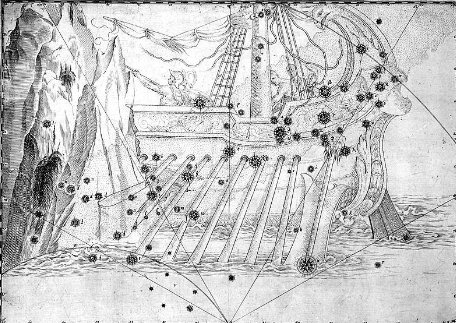
Atea changed her sex from
female to male and thus forced her husband Hotu
(Full Moon) to change from male to female:
... When this tremendous task had been accomplished
Atea took a third husband, Fa'a-hotu,
Make Fruitful. Then occurred a curious event.
Whether Atea had wearied of bringing forth
offspring we are not told, but certain it is that
Atea and her husband Fa'a-hotu exchanged
sexes. Then the eyes of Atea glanced down at
those of his wife Hotu and they begat Ru.
It was this Ru who explored the whole earth
and divided it into north, south, east, and west ...
She went from the stern to the prow
of the ship so to say. The pointed prow was caught in a
net (a canopy):

The Egyptian X asterism visualized
how up became down and down became up (when the
equator was crossed over), and Naos was
what became of Betelgeuze:
.jpg)
 |
 |
 |
 |
 |
|
Gb2-12 |
Gb2-13 |
Gb2-14 (40) |
Gb2-15 (270) |
Gb2-16 |
|
CLOSE TO
THE FULL MOON: |
|
υ¹ Hydrae (148.4),
RAS ELASET BOREALIS (Northern Head of the
Lion) = μ Leonis
(148.7) |
TSEEN KE (Heaven's Record) = φ Velorum
(149.9) |
ν Leonis (150.1), π Leonis (150.6) |
υ² Hydrae (151.8) |
Al Jabhah-8 (Forehead) /
Maghā-10 (Bountiful) /
Sharru-14
(King)
10h (152.2)
AL JABHAH = η Leonis
(152.4),
REGULUS (Little KIng) = α Leonis
(152.7) |
|
Aug 16 (*148) |
17 |
18 (230) |
19 |
20 (191 + 41) |
|
"July 6 (*107) |
7 |
8 |
9 (190) |
He Anakena 10 |
|
... They took their provisions with them,
carrying them on their shoulders, went on,
and reached Te Pou. They made camp
and slept in Te Pou on the tenth day
of the month of July ('Anakena').
[E:22] |
|
CLOSE TO
THE SUN: |
|
KUH (Weeping) = μ Capricorni
(331.4), γ Gruis (331.5) |
no star listed (332) |
η Piscis Austrini (333.4) |
22h (334.8)
KAE UH (Roof) = ο Aquarii
(334.0),
AL KURHAH (White Spot) = ξ Cephei
(334.4),
SADALMELIK (Lucky King),
AL DHANAB (The Tail) = λ Gruis
(334.6), ι Aquarii, ν Pegasi (334.7) |
ι Pegasi (335.0),
ALNAIR (The Bright One) = α Gruis
(335.1), μ Piscis Austrini, υ Piscis
Austrini (335.3),
WOO (Pestle) = π Pegasi
(335.7),
BAHAM = θ Pegasi,
τ Piscis Austrini (335.8) |
|
Febr 15 |
16 |
17 (413 = 14
* 29½) |
18 |
19 (50) |
 |
... the
great high priest and monarch of the Golden Age in
the Toltec city of Tula, the City of the Sun, in
ancient Mexico, whose name, Quetzalcoatl, has
been read to mean both 'the Feathered Serpent' and
'the Admirable Twin', and who was fair of face and
white of beard, was the teacher of the arts to the
people of pre-Columbian America, originator of the
calendar, and their giver of maize. His virgin
mother,
Chimalman
- the legend tells - had been one of the three
sisters to whom God, the All-Father, had appeared
one day under his form of
Citlallatonac,
'the morning'. The other two had been struck by
fright, but upon Chimalman God breathed and she
conceived. She died, however, giving birth, and is
now in heaven, where she is revered under the
honourable name of 'the Precious Stone of
Sacrifice',
Chalchihuitzli.

At the apex of his journey the
swimmer was turned upside down from his midline downwards, he surely died because fishes found
upside down are dead. Another swimmer, his twin,
continued from that point onwards. It is said that
Cleopatra donned a beard - ole, dole, doff. 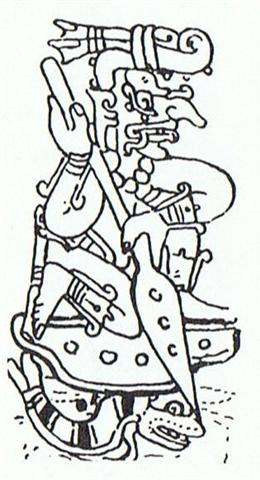 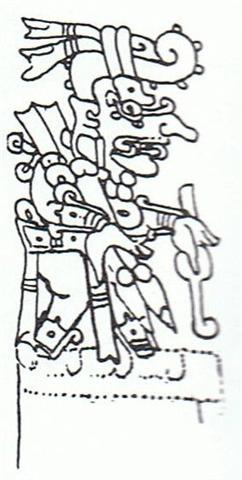 
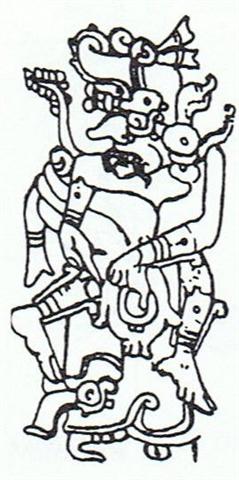 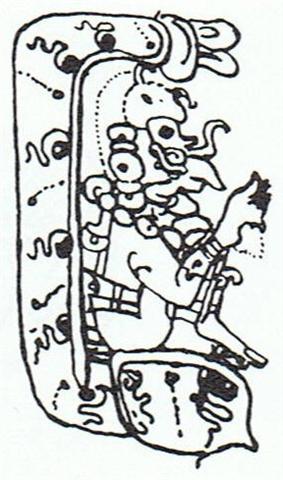 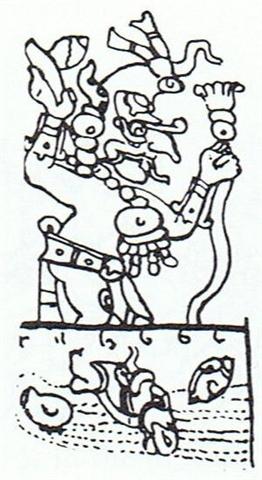 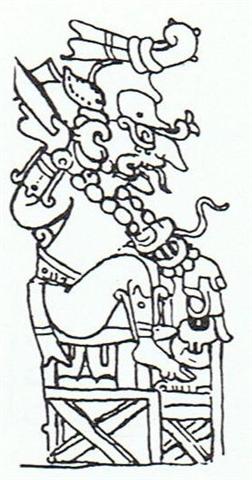
|







.jpg)












